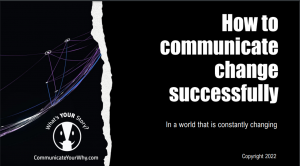 For any of us to be successful moving forward, personally or as organizations, we need to be able to change. Change is nothing new. It has been part of our reality from the day of inception, and will continue long after we become nothing more than a memory.
For any of us to be successful moving forward, personally or as organizations, we need to be able to change. Change is nothing new. It has been part of our reality from the day of inception, and will continue long after we become nothing more than a memory.
So, the question is, why are people so afraid of change?
Our fears stem from uncertainty and the inability to predict the unknown. In reality, those uncertainties and unknowns will happen whether we fear them or not, so we should embrace them and use that energy to answer three simple questions:
- Why?
- Why not?
- What if?
When focused on and given proper consideration, these questions become the cornerstone of developing strategies and tactics to move beyond fear and enable change.
Why?
This is the best place to start. Why are we doing what we are doing? Why are we not getting the result we desire? Why are other organizations or people succeeding (or is it just our perception of them) and we are not?
Why not?
This is being your own devil’s advocate. This is the Red Team Thinking that Bryce Hofmann promotes. It is the time to ask yourself the fundamental risk questions. What is the return on investment of change? What happens if the proposed change fails, and how can we mitigate those risks? What are the potential effects on our teams, purpose, culture, or customers, and how do we reduce those risks? Is this the best direction to go, or is there a better solution, and if so, what is it?
What if?
This is where we get aspirational. If we change successfully, what will this enable us to do that we cannot do now? Who are the people we can influence and help by creating this change? How will this improve the teams we support by going ahead?
Once you have gathered the right people, agonized over these questions and others, the hard part begins…changing.
Change requires adoption not by the few, but by the many. Every stakeholder, inside and outside the organization, needs to now understand why, why not, and what if – and be able to justify this in their minds, which requires consistent and ongoing communication.
Our latest eBook, How to Communicate Change Successfully in a world that’s constantly changing, provides a roadmap to understanding why communication is the cornerstone of successful change, and some practical tactics you can utilize to do so successfully.
As people and leaders, we need to be creative, adaptable, and resilient through change. We need to realize that every change project is different and requires different stakeholders to be read in at various times. Those leading the change must have the ability to be aware of potential and actual pitfalls, pivot as needed, and communicate effectively throughout the process.
None of this is easy. However, the alternative, doing nothing, puts you in a position where you fall further behind and become less relevant. It also creates the situation where it becomes almost impossible to achieve change when you finally decide it is critical.
What are you willing to do to ensure your relevance both personally and as an organization moving forward, and have others perceive you as a leader within your industry and not just another irrelevant commodity, easily ignored and soon forgotten?
_________________
Ben Baker is the CEO of Your Brand Marketing. A strategic communication firm designed to enable you to align your internal teams with change management initiatives and other issues, allowing you all to move forward profitably together.

